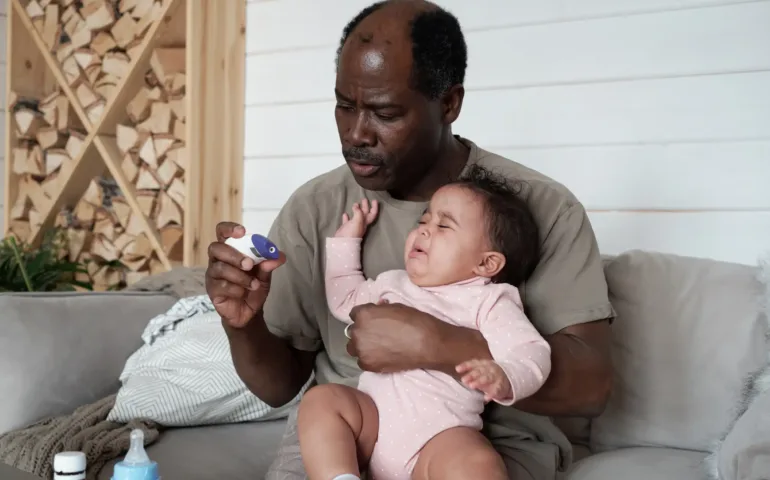
In the first days after birth, your baby keeps a part of the umbilical cord. A slight bleeding at the level of the umbilical cord is a common phenomenon and generally harmless. What should you do if bleeding occurs? When should you consult a doctor?
Bleeding umbilical cord: let’s take a closer look.
Bleeding umbilical cord: is it normal?
During pregnancy, the umbilical cord plays a key role in the development of your baby. Concretely, it connects the fetus to the placenta (the organ that provides your baby with nutrients and oxygen that they need).
After birth, the umbilical cord is clamped with a special clip and then cut (either by your healthcare professionals or by your chosen birth partner named in your birth plan) to separate the newborn from the mother. The cord is then shortened, clamped again, and will eventually fall off on its own within one to three weeks after birth, leaving your baby’s belly button.
During this period, you may notice a small amount of bleeding around the cord. This is a common and generally harmless phenomenon. A bleeding umbilical cord is often due to it drying out and detaching, or to a small friction with the diaper or onesie. This is part of the healing process.
What should you do if the umbilical cord is bleeding?
As we’ve seen, a bleeding umbilical cord in small amounts is a common phenomenon that does not require a specific consultation. There is nothing special to do.
Want to learn more? Feel free to download the May app, where you’ll find plenty of resources to support and guide you throughout your journey as a new parent.

When to consult?
A light bleeding at the umbilical cord is therefore a benign and harmless phenomenon for your baby. However, certain signs should prompt you to consult your doctor or pediatrician.
Signs of infection
- Pus discharge: a yellowish or greenish discharge, sometimes accompanied by a bad odor, may indicate a bacterial infection.
- Redness : a red and warm area around the navel may indicate inflammation or infection.
- Unpleasant odor: a strong, foul smell coming from the cord is a warning sign.
Other concerning signs
- Delayed healing: healing that seems slow or absent may indicate an underlying problem.
- Change in behavior: if your baby cries more than usual or seems uncomfortable when you touch the cord area, this may be a sign of discomfort or pain. It is best to seek medical advice.
If you notice one or more of the signs we just mentioned, or if you feel worried, don’t hesitate to consult your healthcare professional.

Preventing complications: umbilical cord care after birth
Taking care of your child’s umbilical cord helps reduce the risk of complications (such as infection). To do this, nothing could be simpler: you only need water and soap.
Steps to clean the umbilical cord:
- Have ready non-sterile gauze pads and warm water. Avoid pre-soaked wipes and antiseptic products unless otherwise directed by your doctor.
- Soak a gauze pad in warm water and mild soap. Gently lift the clamp or cord to clean its base. Make sure not to wipe the same spot with a used gauze pad.
- Rinse carefully with a clean gauze pad soaked in warm water to remove any soap residue.
- Dry the cord and its base by gently patting with a clean gauze pad. This is an important step to avoid residual moisture, which could encourage infection.
- Leave the cord exposed to air, outside the diaper, to prevent irritation caused by friction or urine moisture.
A bleeding umbilical cord is therefore a common phenomenon in newborns, while the cord detaches and the wound heals. However, if you notice signs of infection, consult quickly your doctor or pediatrician. And of course, in case of doubts or questions, our healthcare professionals from the May team are available via the app chat every day from 8 a.m. to 10 p.m. 😉

**
Photos: prathanchorruangsak | AndreevVisuals | icefront | Image-Source
This text was translated from French by an artificial intelligence. The information, advice, and sources it contains comply with French standards and may therefore not apply to your situation. Make sure to complement this reading by visiting the May US/UK app and consulting the healthcare professionals who are supporting you.




